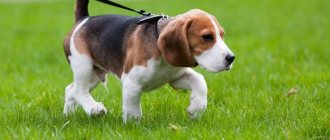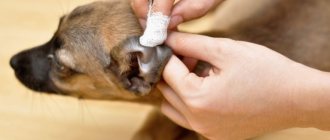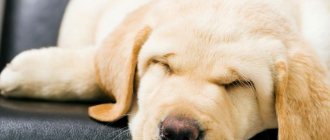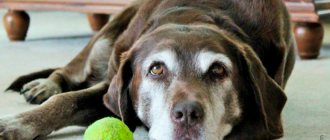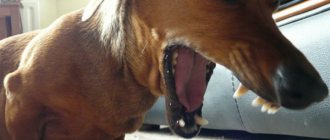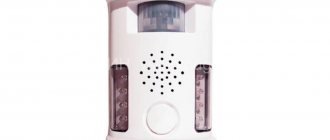Every owner sooner or later is faced with the fact that his four-legged friend is getting old. This is a natural process that causes certain health problems. The animal's motor activity decreases, gray hairs begin to appear on its body, and the spark of curiosity in its eyes goes out. Special care and a balanced diet will help improve the quality of life and prolong it.
At what age does a pet reach old age?
A dog's old age does not occur immediately: irreversible processes in his body occur gradually. Veterinarians classify those pets that have reached the age of 7-8 years as elderly. In addition, the onset of old age is influenced by the size of the dog and its breed:
- In dwarf and small breeds, this period begins at 9-10 years.
- In medium and large breeds, old age occurs at 7-8 years
- Giant dogs age from 6-7 years.
It is not difficult for even the most attentive owner to notice signs of changes. Chronic diseases, loss of motor activity, decreased visual acuity and decreased appetite are signs that your pet is aging. At this moment, the owner begins to think about what to feed his old dog.
Aged dog: pet characteristics
Interesting fact: the lifespan of dogs has become significantly longer compared to the lifespan of dogs in the past. And there are quite a lot of factors that influenced this. This includes high-quality veterinary care, timely vaccination, and, most importantly, high-quality food.
Older dogs begin to experience age-related dysfunction. Pets may growl at children, break house rules, and sleep poorly.
Over time, dogs begin to have difficulty oriented in space. Vision and hearing deteriorate.
The pet's activity decreases, and muscle mass is replaced by fat over time. Your pet's worn-out teeth will fall out. Chronic diseases make themselves felt.
With proper pet care, you can not only improve the quality and lifespan of your pet, but also make your life much easier. After all, caring for an animal that feels good is much easier.
Features of older animals that affect their nutrition
Why is it worth reviewing the old menu and changing it to a more suitable one?
Reduced activity
Having reached a certain age, the once active individual begins to spend more time on the sofa or in the kennel. She does not want to run or accompany a person on walks not because of laziness - she begins to have problems with joints, muscles, and bones. This causes discomfort and even pain to your four-legged friend. The pet will now prefer slow walks in the park and is unlikely to rush to catch up with a stray cat.
This rhythm of life must be approached with understanding: you should not take an elderly dog for active jogging or long hikes. But regular leisurely walks in the fresh air are vital - they will help maintain the old man’s muscle tissue and bones in normal condition.
As activity decreases, so does the need for calories. Now, any excess of the norm is fraught with obesity or liver problems.
Problems with teeth or jaw
Just like humans, four-legged animals' teeth deteriorate after a certain age. Problems in the oral cavity become noticeable due to a specific odor, plaque and tartar. If a young individual could easily get rid of these problems with the help of solid food, then a mature representative, due to the characteristics of the body, is not able to do this.
As a result, inflammation and ulcers appear on the gums. They cause pain, and the pet begins to refuse food.
Even if the owner treats dental problems in a timely manner, it is difficult for the dog to chew pieces that are too large and too hard. Therefore, natural products are finely chopped or ground in a blender, and when dry feeding, smaller granules are chosen.
The emergence of chronic diseases
Due to disturbances in the gastrointestinal tract, difficulties begin with digesting food. Against this background, chronic constipation and allergic reactions even to familiar foods appear. This must be taken into account when preparing an old dog’s diet, excluding some treats.
Attacks of urinary incontinence are also common in pets. They are explained by the development of cystitis or the presence of inflammation in the prostate gland.
With age, visual acuity drops sharply and cataracts begin to develop. Cloudiness of the lens is like a cataract that changes the angle of refraction of the light ray.
Other chronic diseases that develop in old age include cardiovascular pathologies and diabetes mellitus. These are very dangerous illnesses that can greatly shorten the life of a pet. It is recommended to be examined by a veterinarian at least once every 3 months, and also to buy food that is prepared specifically for animals with chronic diseases: kidney disease, urolithiasis, diabetics and others.
Aging dogs
Starting from 6-7 years, the dog’s body steadily ages.
This manifests itself in disruption of the normal functioning of all organs of the body, and with each passing year the disturbances become more and more noticeable. Old dogs usually have difficulty withstanding a change of environment and are less mobile. One of the first signs of aging is the weakening of the animal’s body muscles: the dog’s back and stomach sag, it loses weight, the muscles become flabby and begin to tremble.
To prevent early weakening of your dog's muscles, take him for long walks regularly. If your dog hasn't moved much before, start with short walks and gradually increase their duration.
The vast majority of older dogs will develop osteoarthritis over time if kept in cold, damp conditions. Therefore, it is better to keep the dog in a dry and warm room, on soft bedding. The development of osteoarthritis contributes to the occurrence of muscle pain. Analgesic medications (for example, aspirin) can help reduce these pains.
It is necessary to carefully care for the coat and skin of an old dog and bathe it regularly. If this is not done, the dog’s hair will quickly form into clumps, become dry and covered with dandruff, tumors will appear on the skin, and it will crack.
One of the problems of old age is decreased or complete loss of hearing. Unfortunately, this disease cannot be cured.
Simultaneously with the hearing, the animal’s vision also decreases. Cases of senile cataracts in animals are not uncommon. To alleviate this condition, cataracts are removed through surgery.
Food for older dogs. Proper nutrition is the protection and health of your pet!
One of the most serious problems of old dogs is loosening and loss of teeth and gum disease. If the owner carefully monitors the condition of the animal’s dental system all the time, then this irreversible process can be alleviated. Remove loose teeth in a timely manner, do not give the old dog bones or dry food, and it is necessary to regularly care for the animals’ oral cavity.
As an animal ages, urinary problems may occur. If kidney function is impaired, the dog is forced to drink a lot and, as a result, urinates frequently. It is advisable to walk her as often as possible (sometimes even at night).
Constipation is common in older dogs. Constipation is caused by improper feeding, weak abdominal muscles and low bowel activity. To prevent constipation in your dog, you should feed it only high-quality food.
Another sign of aging is weakening of the heart and the appearance of heart failure. Signs of such a disease are shortness of breath, weakness of body muscles, apathetic state, obesity. It is necessary to reduce the dog's weight with a special diet (food without salt), and also regularly give it diuretics and heart medications. It is extremely important to protect the animal as much as possible from possible stress.
Make sure your dog doesn't get too cold while swimming or overheat in the sun. Try not to change the dog’s usual food: this may adversely affect the functioning of the animal’s intestines and stomach,
In general, an old dog should be treated the same as an old person. For many years she has been your friend and protector and now has the right to count on a calm old age.
Diet: feeding frequency and portion size
Experts recommend feeding an elderly dog twice a day. These are morning and evening meals. Pets consuming ready-made food should be given the amount of product recommended by the manufacturers.
If there are no special instructions on the packaging, then you need to recalculate yourself. An auxiliary calorie table is used for this.
| Breeds | Number of calories per 1 kg of weight |
| Dwarf (up to 5 kg) | 100-120 |
| Small (5 to 10 kg) | 55-95 |
| Medium (from 10 to 20 kg) | 70-80 |
| Large (from 20 to 30 kg) | 60-70 |
| Giant (from 30 to 50 kg and above) | 55-65 |
The daily intake of natural food depends on the size of the elderly dog and is 4% of the total weight. The serving size also depends on the animal's appetite. If he does not eat the proposed amount within 15 minutes, then it is recommended to remove the bowl with the remaining food. Then the pet will have time to get hungry before the next meal and will eat with great appetite.
What if the dog has no appetite?
Some older dogs, on the other hand, lose weight and suffer from lack of appetite. Don't let the process take its course. If your pet refuses to eat, you should immediately contact a veterinarian. The presence of serious chronic diseases should be excluded.
If your pet was kept on dry food in its youth, it is likely that in old age it becomes more difficult for the dog to chew granules.
You can switch your animal to finely granulated food or add broth or canned food to regular food.
Perhaps your veterinarian will advise you to switch your pet to a natural diet.
In our online store you can choose the best food for your pet.
Natural food for older dogs
Food for the old man should be low in calories and must be well digested. The condition of the gastrointestinal tract and the entire body of the animal depends on this.
Authorized Products
Natural food for aging dogs can be difficult to achieve the right balance of nutrients. Therefore, the owner must be very careful when preparing the dish. Standard porridge with meat should be enriched with vegetables, and do not forget about additional feeding. Basic foods for feeding:
- lean meats and offal;
- boiled and raw vegetables and fruits;
- low-calorie fermented milk products and 5% cottage cheese;
- cereals (buckwheat and rice, oatmeal).
A veterinarian can give a lot of useful advice on the natural nutrition of a particular individual. After examining the pet, he will tell you what food will be optimal for the menu. By adhering to his advice and the principles of a balanced diet, you can significantly improve your pet’s condition.
Prohibited Products
Prohibited products for the elderly include approximately the same ingredients as for the young. Pity for an aging four-legged animal should not be manifested in feeding it harmful treats from the master's table. The following are strictly prohibited:
- fatty meats and fish;
- flour products;
- sweets and chocolate;
- berries and beans;
- tubular and boiled bones;
- smoked, fried or pickled foods.
It is better to exclude corn and wheat from cereals for making porridge or soup. They contain mostly empty calories that provide minimal benefit to the animal's body.
Vitamin supplements
Enriching the diet with vitamin and mineral supplements has a positive effect on the condition of the body. Properly selected elements activate metabolism, normalize the functioning of the central nervous system, and accelerate blood supply to internal organs. To maintain the health of an aging pet you need:
- zinc – slows down aging;
- calcium – strengthens bones and muscles;
- glucosamine – promotes joint elasticity;
- lecithin – accelerates the absorption of nutrients;
- proteins - increase muscle mass;
- L-carnitine – normalizes the functioning of internal organs.
Prescribing vitamins on your own is very dangerous. For example, sodium, magnesium and phosphorus negatively affect the functions of the vascular system, leading to the development of urolithiasis and increased blood pressure. Your veterinarian will tell you what vitamins you should enrich your diet with after examination and testing.
When should you contact a veterinarian?
There are a number of signs that in old age can be both a feature of “age-related” behavior and a symptom of a disease. Should not be ignored:
- fatigue during a walk, shortness of breath, cough - may indicate an exacerbation of heart disease;
- “unnatural” thirst and frequent urge to go to the toilet - sometimes this is a signal of a problem with the kidneys;
- loss of appetite and stool disturbances are often caused by disturbances in the functioning of the digestive system or impaired liver function.
Age-related changes are not sudden - a sudden refusal to feed, a sudden increase in fluid intake, significant weight loss/gain are reasons for an unscheduled visit to the veterinary clinic.
Dry food for older dogs
Properly selected high-quality dry food is ideal for feeding older pets. The presence of useful components in their composition makes it possible not to use additional vitamin supplements.
Choosing a dryer for breeds of different sizes
When choosing dry granules, you should give preference to products from a well-known manufacturer. A carefully balanced composition helps regulate the animal’s weight due to reduced fat content and increased fiber content.
For older dogs of large breeds, dry food is offered in the form of large granules. For older dogs of small and medium breeds, the granules in dry food are much finer. Thanks to this, there are no problems with chewing and swallowing food.
Combination of wet and dry foods
Most veterinarians and breeders talk about the need to combine two types of food for dogs over 7 years old. Both products are useful and can effectively complement each other, so it is better to alternate them in your pet’s menu.
For example, older dogs eating dry food has a good effect on the cleanliness of their teeth. By chewing the granules, dogs get rid of plaque and tartar. Fiber in dry food has a beneficial effect on the functioning of the gastrointestinal tract.
Wet food helps saturate the body with fluid, which serves as a good prevention of problems with the urinary system. The variety of flavors and soft consistency of the product will definitely appeal to elderly people with dental diseases.
When to choose a treatment line
In older pets, chronic diseases begin to worsen with age. A special medicinal line of food can cope with their consequences.
Therapeutic food for aging dogs is part of a complex therapy that can only be used as prescribed by a doctor. Independent selection of specialized food for your pet often leads to negative consequences.
Diet for the elderly
The diet for aging dogs should be a delicate balance of protein, fat and fiber. Many dogs are able to eat their regular diet, but in smaller portions. Feeds produced for age-related diets are typically lower in calories and fat, but high in fiber to support good intestinal passage and thus prevent constipation. If your dog has kidney problems, a diet low in phosphorus may be healthy. Protein levels in the diet are also important for dogs with kidney problems; of course, it is most prudent to ask your veterinarian for advice about this.
Leftover food in the refrigerator? Your dog will most likely happily eat them, but please read the next few tips.
Adding vegetables or lean meats such as chicken or turkey to the diet is a great way to increase the amount of essential vitamins and fiber in your dog's diet. Supplementing with white or fatty fish is also very beneficial, and some of the fatty oils in fish can reduce the symptoms of diseases such as arthritis. However, if the meat is prepared at the store, make sure it does not have high levels of sodium (salt) to prevent any additional stress on the heart. Using vegetables can be a good choice for those dogs who need to lose some weight. Supplementing with some grains or grains, such as bran or brown rice (or white rice, which is better for dogs with kidney problems), is also a good idea. In addition, some dogs can tolerate a high-protein diet and occasionally consume boiled eggs.
For many older dogs, a diet of home-cooked and prepared foods is optimal and allows you to 'tailor' it to your dog while you can consult with your veterinarian about which foods are most suitable, ensuring a well-balanced diet without any additives. . However, this does not mean that store-bought food is not suitable for your pet. Whichever option you choose, most older dogs do better on a diet with smaller portions. It is also important that your dog always has access to clean, fresh water.
Feeding frequency for an aging dog
If at a young age the pet was fed 2-3 times a day, an aging dog needs to be fed more often, but in small portions. Just divide the daily amount of feed into 4-5 times, and give out exactly that amount of feed at a time. Such fractional feeding will facilitate easy digestion of food and better absorption, and will also prevent poor appetite and weight loss in the pet.
Once you know how, how much and what to feed your old dog, we hope that your care for your pet will be correct.
Source

